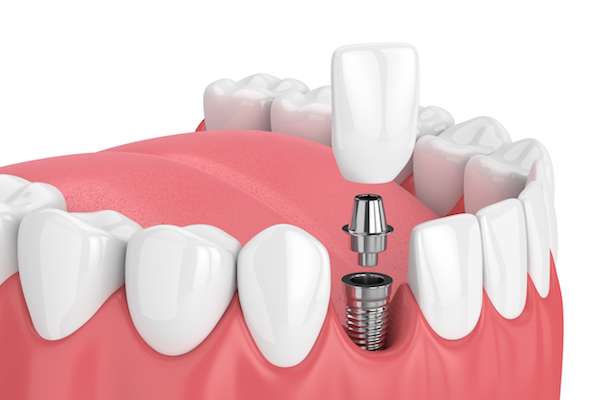All You Need to Know About Implant Supported Denture
Losing a tooth is no longer a life sentence. It is possible to get the lost tooth or teeth replaced with either dentures that rely on bonding or clasping on the teeth or dental implants. Dentures are normally prosthetic devices that are constructed to replace missing teeth. They are normally supported by the surrounding hard and soft tissues of the oral cavity. Both conventional and implant-supported dentures are removable.
Are you looking for new teeth-in-a-day to transform your loose teeth or old dentures into a confidence-boosting smile? If so, we are here for you. We will make sure your self-esteem remains high as you improve your social connections and you will talking, smiling, and laughing without any worries.
What Is An Implant Supported Denture?
The implant-supported denture is an over-denture that is supported by and attached to implants. Unlike the regular denture which rests on the gums, this type of denture is supported by implants. This form of treatment is recommended when a patient does not have teeth in the jaw that can support the denture. The patient must, however, have enough bone in the jaw to support the implants. The implant-supported dentures normally have attachments that snap on attachments on the implants.
In most cases, the implant-supported dentures are for the lower jaw. This is because the regular dentures are less stable on lower jaws. Regular dentures designed to fit on the upper jaw are more stable on their own and don’t need any support that is offered by the implants. All in all, it is good to note that implant-supported dentures can still be used on both upper and lower jaws.
For better oral hygiene, you need to remove your implant-supported denture every day to clean it as well as clean the gum area. Moreover, you should not sleep with these dentures in. For people who don’t like the task of removing the dentures every day and night, dentists recommend fixed crown and bridgework. The dentist will consider your needs before recommending fixed or removable options.
How Implant-Supported Dentures Work
There are normally two types of implant-supported dentures: ball-retained and bar-retained. With both options, the denture is made using acrylic base which looks just like your gums. Acrylic or porcelain teeth that resemble natural teeth are then attached to the base. With either of these dentures, you will need a minimum of two implants for adequate support.
Ball-retained dentures
These are also referred to as stud-attachment dentures. Each of the implants in the jaw holds a metal attachment which fits in another attachment on the denture. The attachments on the implants are in most cases ball-shaped hence the name. The male attachments on the implants fit into the female attachments on the denture to lock the denture in. It is also possible to find a denture in which the denture has the male attachments and the implants have the female attachments.
Bar-retained dentures
This type of implant relies on a bar which follows the curve of the jaw. This bar is attached to two to five implants which have been fastened on the jawbone. Attachments, often clips, are fitted to this bar or the denture or both. The denture will fit over this bar and will be secured in place by clipping using the attachments.
THE IMPLANT PROCESS
Implants are usually placed in the jawbone in the front of your mouth. This is because there is more bone here than in the back. There is always more bone even if the teeth have been missing for a long time. When you lose a tooth, you start losing the bone in that area. Another reason why the implants are placed in the front is because the front jaw does not have as many nerves and other structures that could get in the way of placing the implants.
Several factors affect how fast the procedure is completed. The shortest time frame is usually 5 months in the lower jaw and up to seven months on the upper jaw. During this period you will go through several surgeries and the placement of dentures. It is not uncommon for the whole process to last more than a year. This is more so if your jawbone needs bone grafting or any other preliminary procedure.
In normal cases, you just need two services for the implants to be implanted. The first surgery will place the implants in the jawbone under the gum whereas the second surgery will expose the tops of the implants. You may have to wait 3 to 6 months before you get the second surgery.
In some cases, you can get a one-stage procedure. With this option, the dentist will place the implants and supporting bars in a single step. This procedure has a pretty high success rate.
Initial Consultation
The process of getting implant-supported dentures usually starts with a consultation with a specialist known as a prosthodontist. A consultation with your general dentist might be enough if he/she has advanced training in the restoration and placement of implants.
In the exam, your medical and dental histories will be reviewed. X-rays will also be needed and impressions of your teeth and gums will be done. These impressions help make custom models. It is not uncommon for your dentist to order computed tomography (CT) scans of a patient’s mouth. The CT scan helps locate the sinuses on the upper teeth and the nerves. The scan helps the dentist make certain that the implant placement will not affect the sinuses and nerves. CT scans may also be needed to assess the bone and determine if bone grafting will be needed and the best place to place the implants.
If you are not wearing complete dentures already to replace the missing teeth, the dentist will create one for you. You will need to wear temporary dentures until your implant-supported denture is ready. It takes approximately four visits which span over a period of several weeks to complete the procedure. The temporary dentures will help your dentist determine the best position for the teeth in the final denture.
You can also use your temporary denture as a backup if something ever happens to the implant-supported denture. In some cases, the temporary denture can be used as the final denture so as to cut down on the costs. For this to work attachments will be added to the temporary denture so that it secures over the implants.
After making your temporary denture, the surgeon will use a copy of it as a guide to help place implants in the right position. He will drill holes in the copy of your denture so as to see where to place the implants.
First Surgery
In the first surgery dentures will be placed in your jawbone. In this first surgery, the surgeon will make an incision in your gum where the implants will go in. A hole is then drilled through the bone and the implant is placed inside that hole. The incision is then stitched.
After the first surgery, you must avoid adding too much pressure on your implants. Your temporary denture will, however, be made in a way that it directs the pressure away from the implants. A soft reline (lining next to the gum) may be provided to reduce pressure on the gums.
Once the first surgery is done, you will have to wait for 3 to 4 months before the implants can be placed in your lower jaw. For the upper jaw, the wait is 5 to 6 months. After this period you can go in for the second surgery. During this waiting period, the implants and the bone will have integrated.
SECOND SURGERY
After the implants have fused with the bone, the second surgery will be scheduled. Using X-ray the dentist will determine if the fusion is complete. The second surgery is much easier than the first. The surgeon will make a small incision in the gum to expose the heads of the implants. Thereafter a collar (healing cap) will be put on each implant. The collar will guide the gum tissue to heal properly.
The collar is normally a round piece of metal which pushes the gum away from the head of the implants. This will be left in place for 10 to 14 days. The dentist will adjust your temporary denture to fit over the collar. Additional reline material may be used to secure your denture on the healing abutments.
After two weeks after the healing caps are placed, the dentist will replace them with abutments. By this time the gums will be healed enough for an impression of the gum tissues and abutments to be made. The dentist uses the impression to make a model of your abutments and jaw. The model is then used to create the denture framework as well as the teeth.
DENTURE TRY-IN & INSERTION
A metal bar will be placed on the abutments. A first try of the dentures will be done to see if it fits. If it fits, teeth will be placed temporarily on the framework in wax. You will then be asked to try the whole denture. If everything is fine, the teeth will be secured permanently in the denture framework. The ball or bar attachments will also be secured at this time.
A final visit is needed to insert the dentures. The denture will be clipped on the bar or snapped in the ball attachments. Your temporary denture will get a new reline so that it can be used as a backup.
After two weeks after the healing caps are placed, the dentist will replace them with abutments. By this time the gums will be healed enough for an impression of the gum tissues and abutments to be made. The dentist uses the impression to make a model of your abutments and jaw. The model is then used to create the denture framework as well as the teeth.


I am really interested in what you wrote here. This looks absolutely perfect. All these tinny details gave me a lot of knowledge.
ReplyDeletesame day emergency dentist near me
Great breakdown of implant-supported dentures. I like how you highlighted stability and comfort compared to traditional options. For many patients, understanding the dentures price Philippines alongside long-term benefits really helps in making a confident decision.
ReplyDelete